Judy Malloy’s Seat at the (Database) Table
a Feminist Reception History
Before I read Jill Walker Rettberg’s excellent “Electronic Literature Seen From a Distance: The Beginnings of a Field,” I’d suspected that Judy Malloy’s elision from the electronic literature reception history as the first author of hypertext fiction was attributable to genre. Her comic piece Uncle Roger, a romp through Silicon Valley set in then-present day 1986, didn’t evince the seriousness, ambiguity, and intricate plotting that critics and other purveyors of taste associate with high art. I accepted without question Robert Coover’s 1992 declaration of Michael Joyce‘s afternoon, a story as the “granddaddy of full-length hypertext fictions,” even though Judy’s Uncle Roger pre-dates Michael’s afternoon by at least one year and possibly three, if one measures from afternoon‘s publication date (1990) rather than its introduction to the coterie of enthusiasts who exchanged stories authored on Hypercard and other systems.
Afternoon is a magnificent work that merits its august reputation.
But Rettberg traces the far-reaching implications of Joyce’s reputation in her distant reading, which demonstrates that afternoon is–by an order of magnitude–the most cited and taught work of electronic literature. The status Coover conferred on afternoon in his New York Times review became a self-fulfilling prophecy. It’s such a small thing, just one sentence in the Times; but its impact has been field-defining. Several factors converged to anoint Michael Joyce and submerge Judy Malloy. This talk sketches them with the purpose of seeing how machinic & human procedures collaborate to create conditions that make it less likely women authors will thrive.
Individual actors like Michael Joyce, Judy Malloy and Stuart Moulthrop — all of them pioneers of hypertext in the late 1980s and early 1990s — evinced companionable interest in each other’s work. But the database systems by which that work was shared, discussed & preserved, or NOT shared, discussed and preserved bear the traces of human cultural values & biases. Michael Joyce’s fame and Judy Malloy’s relative obscurity are products of dialectics of inclusion & exclusion that replicate, with numbing fidelity, the traditional privileges that digital media have the capacity to disrupt but often do not.
John Scalzi redescribes white male privilege as a role playing game. He writes:
How to get across the ideas bound up in the word “privilege,” in a way that your average straight white man will get without freaking out about it? Being a white guy who likes women, here’s how I would do it:
Okay: In the role playing game known as The Real World, “Straight White Male” is the lowest difficulty setting there is.
This means that the default behaviors for almost all the non-player characters in the game are easier on you than they would be otherwise. The default barriers for completions of quests are lower. Your leveling-up thresholds come more quickly. You automatically gain entry to some parts of the map that others have to work for. The game is easier to play, automatically, and when you need help, by default it’s easier to get.
Scalzi’s is a great description of how sexism can happen without malice or even intention. In an interview with Jill Rettberg, Stuart Moulthrop describes how at the 1989 Hypertext conference he, John McDaid, Michael Joyce and Jay Bolter sat at a computer connected to the Internet and searched for other people doing similar things. They found Judy Malloy’s work:
“It was just like blues men going to each other’s performances. Yeah, allright, oh darn that’s good. Oh, we’re not that good. So we really recognized that she was somebody, and she was part of a community out there in the Bay Area that was really important and exciting. I can remember coming away from that moment thinking that, you know, there might be a real hope for what we were trying to do because other people were doing it. (Moulthrop, personal interview, cited in Rettberg, “Distant Reading”)
Michael Joyce, Stuart Moulthrop and many of the men I know in the e-lit community are feminist supporters who individually act to redress power imbalances when brought to their attention. Michael and Stuart are tenured full professors at elite universities. None of the pioneering e-lit women authors I’ve met occupy the tenured positions that their male colleagues earned. Just one decade later, in the early 2000s, women e-lit artists did make in-roads to university power. Caitlin Fischer and Dene Grigar direct their own programs at R-1 universities. But women of Judy Malloy’s generation were not encouraged to enroll in graduate programs.
In his 2012 book The Interface Effect, Alex Galloway glosses Lev Manovich’s Language of New Media: “to mediate is really to interface. Mediation in general is just repetition in particular, and thus the ‘new’ media are really just the artifacts and traces of the past coming to appear in an ever-expanding present” (10).
Literary history always reflects back an uncanny distortion of one’s own cultural moment, and here’s ours: at this conference I’ve heard a proliferation of tools, brilliant ways of doing new work. But I also hear, resonating in the back of my mind, Miriam Posner’s post from March 2012, “Some things to think about before you exhort everybody to code“:
The point is, women aren’t [learning to code]. And neither, for that matter, are people of color. And unless you believe (and you don’t, do you?) that some biological explanation prevents us from excelling at programming, then you must see that there is a structural problem.
Judy Malloy is almost entirely a self-taught programmer. More specifically she’s a conceptual artist who dreamed up the idea of molecular storytelling while working with books she made from card catalogs in 1977. Later, as a single mom, she supported herself and her son working with technical information, including jobs as a technical librarian and a library assistant for several research and technical companies. On the WELL in 1986, she saw in the Art Com Electric Network bulletin board database a much more efficient mode of non-sequential storytelling than the card catalogs. She ended up writing 32 UNIX shells and even built in a Boolean operator (“and”). She built this system so that she could perform “live writing,” a “Homeric” experience she likens to Twitter today.
Extending Miriam’s point about women and code: even Judy’s undisputed capacity didn’t insulate her against sexism. Nor did the goodwill and respect from the other practitioners in her community. This is a human problem without a tool solution. But it’s possible that mindful use of tools could ameliorate the problem this reception history discloses.
The disequilibrium happened gradually over time. There is no villain twirling his moustache. While it circulated on the prestigious museum & gallery scene from 1987-1989, Uncle Roger excited interest in the popular press. It was singled out in the Centennial Edition of the Wall Street Journal (published on June 23rd, 1989), and mentioned in Newsweek. But the acclaim it garnered was pre-web. It is algorithmically invisible.
Afternoon’s ISBN, and Uncle Roger’s lack of one, is the second crucial differentiator in Judy and Michael’s divergent receptions. The presence or absence of an ISBN determined access: whether a work could be archived, collected and sold. The ISBN united disparate stewards (programmers/developers, librarians, academics, vendors) to collect and fortify those few works against bit-rot or obsolescence. The vast majority lacked an ISBN, and those were the responsibility of the authors to maintain or abandon. It would be much later (1997) before Malloy would author Uncle Roger in a browser-friendly format. By then excitement for the novelty of hypertext had given way to interest in Flash-based works. A moment had passed and with it, the power that comes from cultural currency.
“Structuralism is the midpoint on the long modern path toward understanding the world as system,” notes Alan Liu in his May 2013 PMLA article “The Meaning of the Digital Humanities.”
(…for example, system as modes of production, Weberian bureaucracy; Sausserian language; mass media & corporate society; neoliberalism; and so on). [These have] forced the progressive side of the humanities to split off from earlier humanities of the human spirit (Geist) to adopt a world view in which, as Katherine Hayles says, ‘large-scale, multi-causal events are caused by confluences that include a multitude of forces…. many of which are nonhuman.’ This is the backdrop against which we can see how the meaning problem in the digital humanities registers today’s general crisis of meaningfulness in the humanities (418-419).
The Malloy/Joyce reception history gives us a cogent example of how “the meaning problem” is a human and nonhuman collusion. “Michael Joyce” is a searched term linked forever by page-rank algorithms to “hypertext” and “electronic literature.” We here at DH 2013 learned about auto-completion algorithms in Anna Jobin and Frederic Kaplan’s talk in which they asked: “are Google’s linguistic prostheses biased toward commercially more interesting expressions?” Evidence they presented suggests that it is. Given that afternoon could be purchased and Uncle Roger could not, we can see how the financial interests of the New York Times and Amazon would begin to align, and how that alignment would manifest itself algorithmically.
It’s also worth noting that even if he had sought one, there is no reciprocal term that Coover could have used to deem Malloy a progenitor. “The grandmammy of hypertext fiction”? The “grand dame of hypertext fiction”? That would not work.
Put bluntly, the language to represent Judy Malloy’s achievement did not exist for Coover. He’s a wily guy, and he could have invented something. But it was not thinkable: to look to the west coast for literary origin, to esteem comedy more than tragedy, to recognize coterie distribution over a press, to praise a single mom with a Bachelor’s degree over a young male novelist with a print novel under his belt, and an MFA from the Iowa Writer’s Workshop. Such are the human judgments that launch a million clicks.
Coover didn’t invent “granddaddy” to describe Michael Joyce’s fiction. He invented Michael Joyce to inhabit “granddaddy.” In 1992, I wonder whether folks at Vassar, where Michael Joyce teaches, noted Coover’s pronouncement. Maybe someone cut it out from the Times and taped on the door of the English department or tacked it on a cork bulletin board. It would not have been conceivable in 1992 that the impact of that endorsement would be measurable, let alone field-defining, 20 years hence. But distant reading permits us to see just that.
By way of conclusion I return to Alan Liu’s argument about the “crisis of meaning” in the humanities. I offer you a tableau. Duke University’s Rubenstein Library purchased Judy Malloy’s Papers. The collection features Judy’s
• Printed Materials
• Notebooks
• Early Artists Books
• Writings and Programming
• Exhibitions, Talks and Readings
• Correspondence
• Media by Other Artists and
• Personal Materials
It is 15.6 linear feet. 13,200 items.
Judy herself, however, has a 1-semester Anschutz Distinguished Fellowship in American Studies at Princeton this fall. She continues to seek a university job.
This is the signal gesture of the neoliberal university: to regard thinkers as content providers. To make financial commitments toward what can be digitized (and scaled) but less and less to people themselves. Code expertise is no safeguard. Publication is no safeguard. Collegial esteem and prolific output are no safeguard.
Last night Willard McCarty said, you do it for love. I see that, feel that, and yet am suspicious of that.
Post-Script
October 17, 2013
Judy Malloy notes this correction: “[T]oday being #ADL13 [Ada Lovelace Day] I have a request. In your otherwise wonderful article about Uncle Roger, you say that I am a self taught programmer. Actually that isn’t true. I did a graduate seminar in Systems Analysis at the University of Denver and I took a company sponsored course in FORTRAN when I worked at Ball Brothers Research Corporation in Boulder, where I headed a team that created a computerized library catalog in 1969, a time when this was an accomplishment. However, I did teach myself UNIX shell scripts and BASIC in order to create Uncle Roger. Generally it isn’t to difficult to move between similar systems.”

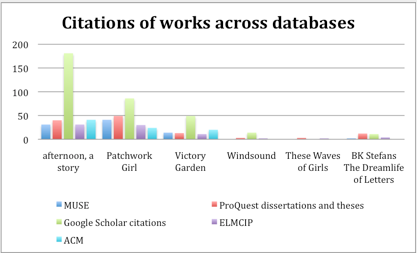
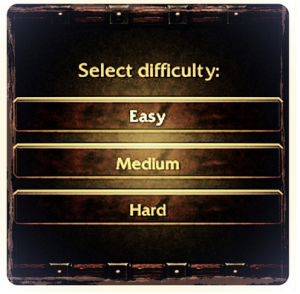
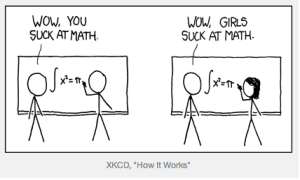
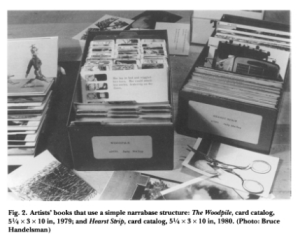
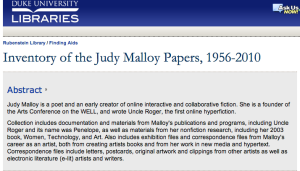
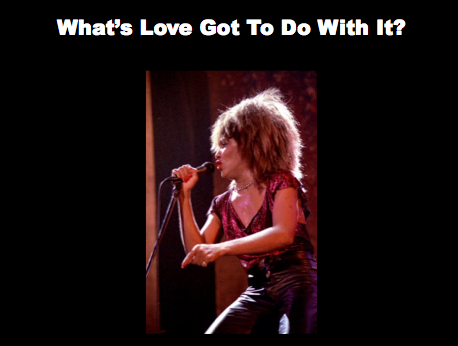





Pingback: He’s not the linkspam; he’s a very naughty boy (2 Aug 2013) | Geek Feminism Blog
I had the privilege of inhabiting the Tech(No)Culture bitnet listserv from 1988 on (subscribers and participants included just about everybody who became anybody in cyberculture/hypertext). There I saw this exclusionary process in action. The interesting thing is that Michael Joyce & Stuart Moulthrop did speak in admiring terms about Judy Malloy’s work, and that few picked up on it. Mark Bernstein, who wrote Storyspace and Tinderbox, set about to publish the work of a lot of the early women hypertext writers at Eastgate (eastgate.com) and promoted them just as energetically as he promoted the men. (I remember him encouraging me when I was thinking about writing a hypertext (though I never did do it). He’s responsible for bringing the work of many of these talented women to public attention.
At that time, all they hypertext writers and poets were struggling to make hypertext art and none were established — almost no one involved in hypertext writing at the time had secure employment, though the people developing the technology often did. At the same time, Tech(No)Culture as a whole was masculinist. Feminist and lesbian participants endured an ongoing, usually low level of abuse (microagressions, we’d call them now). Things would explode occasionally (I remember Terry Harpold’s post on the wonders of Virtual Valerie, which started what many of us called for years the Great White Het Male Flamewar), and at one point George Landow accused me of being a bot instead of a real person because I wrote such profuse “nonsense” about feminism and cyberculture (occupying more space than was my due, apparently, although many men wrote just as much as I did). What I do remember quite clearly is that the women on the listserv had to work much harder to be heard, and garnered far fewer responses to their posts, except if they critiqued gender politics, in which case they were buried under a flood of snark. (Antifeminist women were championed by men when they agreed with the guys that sexism wasn’t a problem, but were just as ignored as the rest of us most of the time.)
Hi-Pitched Voices was formed by Carolyn Guyer (every bit Michael Joyce’s equal, as I think he would have been the first to say) in the early 1990s by women hypertext writers and did some very creative work. Most of the women involved had been active on Tech(No)Culture, and some were motivated to create a woman’s hypertext space because of their experiences there. Kathryn Cramer was in the group, and Anne Johnstone, but I’d have to dig around in my archives for the names of the others, though I recall the notices going around, and for a while I was on the associated listserv. But the name tells you everything about its intent, since it was chosen right about the time that studies were coming out claiming men “couldn’t” hear women’s high voices, and speech recognition programs were also not working well for us. The reference to not being heard was very, very clear. The point of women’s erasure is driven home if you look at the “histories” of hypertext: you’re lucky if you find a mention of the group. Carolyn is always described as the founder, but the other women’s names are almost never mentioned, though most of them did notable work.
There were feminist men on the list, and some were very outspoken, but the majority of these would give back channel encouragement to women, rather than arguing with their male peers. A few (I remember Joe Amato and David Porush in particular) would turn the arguments on their head, and I considered them strong allies… but often these wonderful allies also were also marginal in the halls of academe & literature. Academics like Richard Grusin, who made no attempt to hide their sexism, were allowed to roam the halls unchecked and when women got pissed about it, we suffered the usual “too sensitive” critique as well as swipes at our expertise. So it does not surprise me that the memory of hypertext history has a masculine shape, because even in the beginning (and women were always in the thick of it) we were pushed to the margins. But not by the artists, usually (Michael and Stuart certainly came to my defense frequently, and made public antisexist statements). Instead, I saw the tendency to enforce masculinity coming mostly from male academics whose drive was to interpret and be “expert” in the field.
The situation is not unique to hypertext. Part of the “citation problem” is the narrow view people take towards literature by women and minorities. Critics reviewing a book by a man will tend to compare it to great works of literature (to its credit or detriment). But literature written by women and minorities tends to be compared to other literature in the same “genre” and rarely connected to a larger literary tradition. This critical bias (the tendency to automatically assume white male literature is “universal” and literature by women and minorities is “niche”) affects hypertext as much as any other format. When the presumption is that these works have only narrow relevance, it’s no wonder that they’re lost over time, no matter how wonderful they are.
During my research for my first book (Women in Particular: An Index of Notable American Women) I was stunned to find thousands of women who had been very well known in their own time and region, and had completely disappeared a generation or two later. It is often said (by modern critics who don’t even bother mentioning many of the writers of best-sellers, pioneers of technology, or policy makers) that their work just wasn’t “of lasting quality,” but that sounds like an excuse for male appropriation of women’s work and erasure of their contributions. I’ve made this point about African American literature and thought as well — I wrote a seminal article on African American literature and philosophy and hypertext for WIRED (Unbearable Whiteness of Being) that pointed out the neglect of African American critics and writers who prefigured postmodernism, and whose work had relevance to the field. The result? Everyone writing on race & cyberspace quotes it, but virtually none of the “establishment” cyberculture writers ever mentions it: the presumption is that it has no relevance to their work. The result is that cyberculture studies retains its white bias. Women’s hypertext has been similarly marginalized by a largely male establishment, and so you oftensee hypertext works by women discussed in books by and about women.
Dr. Tal, thank you for this informed response. There’s so much to engage here.
I just read your WIRED piece and also the longer piece from which it’s culled, “The Unbearable Whiteness of Being.” As I was curating books for the first Showcase of Electronic Literature at the Library of Congress, I identified a number of books by African American writers as influential on early hypertext. This is unusual, since most of the recognized antecedents are patterned literary games by the Oulipo or forking narratives by experimentalists like Cortazar & Borges, or “cut up” works by Burroughs. But as you say in “Unbearable Whiteness” (1996): “African American critical theory provides very sophisticated tools for the analysis of cyberculture, since African American critics have been discussing the problem of multiple identities, fragmented personae, and liminality for over a hundred years.” That’s why I placed Ishmael Reed, Samuel Delany, Toni Cade Bambara & Toni Morrison alongside the “recognized” influences. Zora Neale Hurston produced short plays especially for the Library of Congress; these struck me as a potentially rich source text for early h/t, but it wasn’t possible to retrieve and hear these items virtually in advance of our show.
Joyce A. Joyce wrote in 1995: “‘Blackness’ is not a material object or an event but a metaphor; it does not have an ‘essence’ as such but is defined by a network of relations that form a particular aesthetic unity.” The “network of relations” certainly informs the practice of early hypertext. Carolyn Guertin articulates such an affinity in Queen Bees and the Hum of the Hive (1998), a critical work about 5 feminist hypertext authors that is itself hypertextual. Carolyn’s essay won a CyberExcellence Award, though I don’t know anyone today who teaches this splendid work. Diane Greco’s “Female Writing” in Hypertext & Hypermedia, and Chris Funkhouser‘s & Judy Malloy‘s separate discussions of HiPitchedVoices, a feminist group of h/t writers working in a wing of Brown Univ’s Hypertext Hotel MOO, all talk about these networks of connected writing in cool, interesting ways.
At our DH 2013 “Excavating Feminisms” panel Kathy Harris asked: “If the traditionally marginalized authors are marginalized because it’s no longer innovative to digitize and mark-up [feminist recovery projects], then how far have we really come?” The archive was meant to dismantle the ghetto. Instead, it might have turned “marginalized” women writers into projects that are also “the Projects”: gigantic databased structures where such works live isolated together, away from the action in the Big City where literary reputations are published, hotlinked and reinscribed again and again by page-rank algorithms.
Rebecca Sutton Koeser is the lead developer & scholar behind Networking Belfast, “an examination of the networks of the Irish poets collectively known as ‘the Belfast Group.'” Brian Croxall is the Project Manager. Together Rebecca and Brian presented a poster at DH 2013 about this project’s “attempt to provide tools for archivists to expose the information embedded in the descriptions of their collections as well as a test case for analyzing that data.” This Twitter exchange between Rebecca, Brian and me adumbrates some of the key points that a group of us discussed we reviewed the poster.
I have hope that data viz might be another route in, another appeal to the powerful to recognize how seemingly tiny, unrelated decisions build and sustain a system that elides, hides or diminishes work by women.
This is a human problem, not a tool problem. “Incapacity” to hear “High Pitched Voices” in the late 1990s could easily transmute, fifteen years later, to data viz blindness. I don’t know how to remedy this problem other than to keep talking.
I notice, Dr. Tal, that you’ve evolved your practice beyond literature to include sociology, medicine, clinical psychology and cognitive science in your work as Scientific Editor of the Institute of Social and Preventive Medicine at the University of Bern, Switzerland.
Would you have time and interest to tell people about the evolution of your practice? How and why did you move out of humanities-based academia and into the interdisciplinary work in Trauma Studies, a field you helped to build?
The journey across disciplines has taken over 20 years. It’s a pretty long story but I’d be happy to tell it if there’s interest.
To address your other question about moving out of humanities-based academia, I think my work in Trauma Studies is still pretty firmly based in the humanities, and that it has just expanded across more of the social science/medicine disciplines. Humanities scholarship, in my eyes, encompasses the sciences & social sciences (rather like objectivity is a subset of subjectivity — a small space within which we can generally agree upon certain standards of measurement). You can’t do science or think about science or write about science without also “doing humanities”, however much some scientists would like to argue that’s not so. For example, I edit scientific papers, all of which have designs on their audiences, and all of which employ rhetoric to convey their message through narrative. Unless you operate in the realm of pure math, that’s pretty much the only way to communicate about your work. If you create tables and charts, you use composition and color and other visual arts to make your point. I could go on about this, but, at bottom, I’m pretty sure that my training as a semiotician and as a feminist and critical race theorist make me a better scientific editor because it’s easier for me to interrogate the frame of a paper and its underlying rhetorical strategy than it might be for others who haven’t learned to think in terms of literary criticism and social theory.
As a scholar, I’m happiest playing on the margins, where there’s a lot of space for invention, synthesis and exploration. This is why I wound up writing about trauma studies when no one had yet defined it as a field, and how I came up with the idea that there’s a “literature of trauma” that crosses the boundaries of specific traumas to create a larger genre. And it’s how I wound up writing about race and cyberspace when most everybody else was writing about it as place where you could be “liberated” from your bodily identity. These days, I’m very interested in trauma as a threat to public health, which nobody really wants to talk about either. Everybody wants to talk about “cures,” and I’m pretty sure there isn’t one — that trauma is a social mechanism that evolved along with human hierarchies, and that violence prevention is where it’s at, rather than post-trauma treatments. I see the increasing medicalization of trauma and its treatments as a distraction from the structures of oppression that create and perpetuate trauma across populations and generations, so I spend a lot of time thinking about science in the context of politics — neither is a substitute for the other, but they definitely interact…
Pingback: Labor of Love? | triproftri
Pingback: Ladies Last: Eight Inventions by Women That Dudes Got Credit For
Pingback: Ladies Last: Eight Inventions by Women That Dudes Got Credit For | The Daily Drudge Report
Pingback: Never Neutral: Critical Approaches to Digital Tools & Culture in the Humanities | Josh Honn
I seem to be late to this conversation. A nice piece, Kathi.
Uncle Roger was actually released in a Web friendly version first in 1995, so it was a pretty early arrival to the open and accessible online crowd, as it had been when the WELL was the only game in (the BBS global) town.
And I position Malloy at the head of the table in Queen Bees and the Hum of the Hive. In that work I say:
‘The first electronic hyperfiction was written by Judy Malloy in 1986. Uncle Roger, called a “narrabase” by Malloy, was envisioned by her as a “pool of information into which the reader plunges repeatedly” (Malloy, 1998). While graphics and colour have been added for the 1995 web translation, Malloy originally posted this on the equivalent of an online conference, the Art Com Electronic Network on the WELL. More than a text, it was an online interactive experience: the audience reacted, commented and made additions to the narrative (Malloy, 1998).’ from http://beehive.temporalimage.com/content_maps/12a.html
Out of “Queen Bees” came “Assemblage: The Women’s Online New Media Gallery” (http://tracearchive.ntu.ac.uk/traced/guertin/assemblage.htm), which was housed at the trAce Online Writing School until 2005 and is now archived in the British Museum.
Carolyn Guertin
Pingback: Privacy, Obscurity, Openness, & Privileging Already Privileged Notions | Laurie N. Taylor
Pingback: Cumadóirí Dearmadtha ag an Stair | abairliom